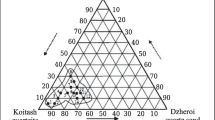Results are provided for refractory materials developed on basis of both secondary resources (broken chamotte refractory, mullite-containing waste, and aluminum melting slag), fireclay, and phosphoric acid. A relationship is established for physicochemical and strength properties of the materials on additive content, filler fractional composition, and also firing temperature. It is stablished that the optimum aluminum melting slag and mullite-containing waste contents are 5% and 15% respectively. The material produced with a firing temperature up to 1200°C has density of 1785 – 1795 kg/m3, open porosity of 20 – 23%, ultimate strength in compression of 40 – 50 MPa, and thermal shock resistance of 30 – 50 thermal cycles (1000°C – water).




Similar content being viewed by others
References
G. D. Semchenko, Unmolded Refractories [in Russian], NTU KhPI, Khar’kov (2007).
G. D. Semchenko, Refractory Objects for Lining Production Heating Units [in Ukrainian], NTUKhPI, Kharkiv, (2009).
U. Sh. Shayakhmetov, V. A. Shchepelin, K. A. Vasin, and I. M. Valiev, “Experience of using ceramic and refractory material in industry based on a phosphate binder,” Ogneupor. Tekhn. Keram., No. 2, 26 – 31 (2004).
I. D. Kashcheev, K. K. Strelov, and P. S. Mamykin, Refractory Chemical Technology: Handbook [in Russian], Intermet Inzhiniring, Moscow (2007).
V. A. Kopeikin, A. P. Perova, and I. L. Rashkovan, Materials Based on Metal Phosphates [in Russian], Khimiya, Moscow 91976).
S. V. Sokolova, “Effect of structure-energy properties of metal hydroxides on chemical binding with orthophosphoric acid with the aim of obtaining phosphate binders for heat-resistant concrete,” Ogneupor. Tekhn. Keram., No. 9, 29 – 31 (2004).
A. T. Volochko, I. A. Belov, and O. G. Batsevichus, “Study of physicochemical processes during heating heat-resistant materials based on phosphate binder,” Vestn. NAN Belarusi, Ser. Fiz.-Tekhn. Nauk, No. 3, 40 – 43 (2003).
L. B. Khoroshavin, P. N. D’yachkov, and B. V. Ponomarev, “Effect of phosphoric acid concentration on some properties of finely milled refractory materials,” Refractories, 9(3/4), 166 – 169 (1968).
I. L. Glinka, General Chemistry: 3 rd ed.[in Russian], Khimiya, Moscow (2001).
G. N. Aleksandrova, Heat-Resistant Concrete Based on Phosphate Binder [in Russian], TsINIS, Moscow (1971).
V. Vezer, Phosphorus and its Compounds [Russian translation], Izd. Inostr. Lit., Kimiya, Leningrad (1962).
M. M. Sychev, Inorganic Adhesives [in Russian], Khimiya, Leningrad (1986).
L. G. Sudakas, Phosphate Binder Systems [in Russian], RIA Kvintet, St. Petersburg (2008).
L. D. Pilipchatin, V. I. Kozdoba, A. S. Lutsenko, and V. V. Pescanskaya, “Determination of phosphoric anhydride in gaseous products of clay and chamotte mix based on phosphoric acid heat treatment,” Ogneupory, No. 1, 17 – 20 (1993).
P. P. Budnikov and L. B. Khoroshavin, Refractory Concretes Base On Phosphate Binders [in Russian], Metallurgiya, Moscow (1971).
A. T. Volochko, K. B. Podbolotov, and E. M. Dyatlova, Refractories and Refractory Ceramic Materials [in Russian], Belarus. Navuka, Minsk (2013).
U. Sh. Shayakhmetov, Phosphate Composite Materials and Experience of their Application [in Russian], Staray Ufa, Ufa (2001).
S. Arun, Chemically Bonded Phosphate Ceramics, Elsevier (2016).
Yu. B. Kharybina, Ya. N. Pitak, and O. Ya. Pitak “Unfired mullite-corundum refractories based on phosphate binder,” Visnik NTU KhP, No. 7, 141 – 146 (2014).
A. P. Luz, D. T. Gomes, and V. C. Pandolfelli, “High-alumina phosphate-bonded refractory castables: Al(OH)3 sources and their effects,” Ceram. Int., 41(7), 9041 – 9050.
Author information
Authors and Affiliations
Corresponding author
Additional information
Translated from Novye Ogneupory, No. 12, pp. 9 – 13, December, 2018.
Rights and permissions
About this article
Cite this article
Podbolotov, K.B., Volochko, A.T., Khort, N.A. et al. Refractory Materials Based on Secondary Resources and Phosphate Compounds. Refract Ind Ceram 59, 579–582 (2019). https://doi.org/10.1007/s11148-019-00276-3
Received:
Published:
Issue Date:
DOI: https://doi.org/10.1007/s11148-019-00276-3




